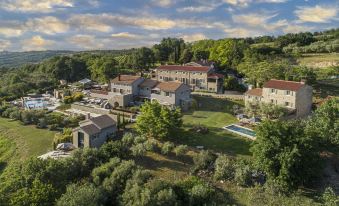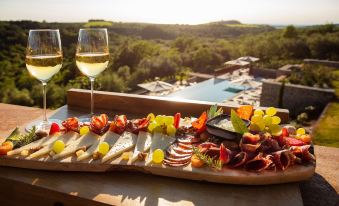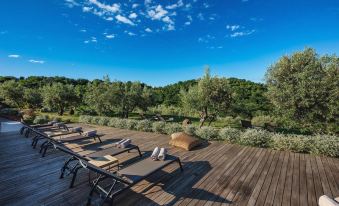San Canzian Hotel & Residences - Small Luxury Hotels of the World
1 nat
Værelser og gæster
1 værelse, 2 Voksne, 0 Børn
Alle overnatningssteder i Krasica
San Canzian Hotel & Residences - Small Luxury Hotels of the World
Mužolini Donji 7, 52460 Krasica, Istria County, Kroatien
Vis på kort
Vi matcher prisen







 Højdepunkter
Højdepunkter Lækker morgenmad
Lækker morgenmad Transport til lufthavnen tilbydes
Transport til lufthavnen tilbydes Gratis parkering
Gratis parkering Masser at gøre
Masser at gøre Kæledyr er velkomne
Kæledyr er velkomneFaciliteter
Udendørs swimmingpool
Ridning
Vandring
Sauna
Massagerum
Privat parkeringGratis
Afhentning i lufthavnen
Biludlejning
Alle faciliteter
Beskrivelse af overnatningssted
Med et ophold på San Canzian Hotel & Residences - Small Luxury Hotels of the World er du klar til at slappe af efter en dags rejse.
Vis mere
9,3/10
FantastiskRenlighed9,3
Faciliteter9,3
Placering9,3
Service9,3
Alle 46 anmeldelser
Omgivelser
Vartegn: Gambaletto Winery & Extra Virgin Olive Oils
(820m)
Vartegn: Clai
(1,4km)
Vartegn: Eco Gecko's Mini Autokamp
(1,9km)
Vartegn: NTC Sophia Centar
(2,6km)
Vartegn: Grožnjan city
(3,0km)
Se på kort
Oversigt
Værelser
Gæsteanmeldelser
Tjenester & faciliteter
Politikker

4
Family Duplex
Soveværelse 1:1 Kingsize-seng ● Soveværelse 2:1 Kingsize-seng
Gratis Wi-Fi
Ikke-ryger
Aircondition
Eget bad
Minibar
Shampoo
Tjek tilgængelighed

8
Superior-værelse
1 Kingsize-seng
Har vindue
Gratis Wi-Fi
Ikke-ryger
Aircondition
Eget bad
Minibar
Privat toilet
Tjek tilgængelighed

9
Maisonette Suite
2 Kingsize-seng og 1 Sovesofa
Har vindue
Gratis Wi-Fi
Ikke-ryger
Aircondition
Eget bad
Minibar
Privat toilet
Tjek tilgængelighed

5
Villa San Canzian
1 Queensize-seng
Har vindue
Gratis Wi-Fi
Ikke-ryger
Opvarmning
Stikkontakt til enkelt specifikation
Wi-fi på værelset
Tjek tilgængelighed

7
Deluxe-værelse
1 Kingsize-seng
Har vindue
Gratis Wi-Fi
Ikke-ryger
Aircondition
Eget bad
Minibar
Privat toilet
Tjek tilgængelighed

14
Executive-værelse
1 Kingsize-seng
Har vindue
Gratis Wi-Fi
Ikke-ryger
Aircondition
Eget bad
Minibar
Privat toilet
Tjek tilgængelighed

4
Familie-suite
1 Kingsize-seng og 2 Enkeltseng
Har vindue
Gratis Wi-Fi
Ikke-ryger
Aircondition
Eget bad
Minibar
Privat toilet
Tjek tilgængelighed

6
Romantisk Suite
1 Kingsize-seng
Har vindue
Gratis Wi-Fi
Ikke-ryger
Aircondition
Eget bad
Minibar
Privat toilet
Tjek tilgængelighed

10
Eksklusiv villa, flere senge, pooludsigt
Soveværelse 1:2 Enkeltseng ● Soveværelse 2:1 Kingsize-seng ● Soveværelse 3:1 Queensize-seng
Gratis Wi-Fi
Ikke-ryger
Aircondition
Eget bad
Køleskab
Minibar
Tjek tilgængelighed
Skjul værelsestyper
Gæsteanmeldelser
9,3/10
Fantastisk
46 anmeldelser
 Bekræftede gennemgange
Bekræftede gennemgange- Renlighed9,3
- Faciliteter9,3
- Placering9,3
- Service9,3
Gennemsnit for lignende overnatningssteder i Krasica

Gæstebruger
8. november 2024
객실상태 좋고 분위기가 좋습니다. 조식도 모두 주문조리 방식인데 맛있어요.
Oversæt

Anđelka V
13. april 2025

A truly unforgettable experience! The location is absolutely perfect, offering both peace and breathtaking surroundings. The rooms are beautifully designed, just like the rest of the estate – stylish, comfortable, and full of character. What really sets this place apart is the incredible staff: warm, professional, and impressively knowledgeable. A special mention goes to the amazing young team in the restaurant – their energy and attention to detail made every meal a joy. From start to finish, everything was thoughtfully curated. Can’t wait to come back!
Oversæt

ThePlayerbookazine
8. januar 2025

For those of you who have not heard of Istria, it is the largest peninsula within the Adriatic Sea, located at the very top of the Adriatic between the Gulf of Trieste and the Kvarner Gulf. This peninsula is shared by three countries, Croatia, Slovenia, and Italy, however, 90% of its area is part of Croatia with just a thin slither over the border in neighbouring Slovenia. Istria is only a three-hour drive from Vienna and just 90 minutes from Trieste, the region feels a world away from the Dalmatian resorts and islands further south. Many visitors to Istria remark that it just feels different from the rest of Croatia. You’ll find a greener landscape and plenty of charming, unspoiled towns which are away from the main tourist trail. The region is famed for its beautiful medieval towns, jewelled coastline, and magnificent produce, surely that’s enough good reasons for anyone to visit this stunning area. As with the rest of Croatia, the best time to visit Istria is between late Spring in the months of May and June, through to September and early October. Given Istria’s proximity to Germany, Austria, Italy, and the Balkans, it’s a hugely popular summer holiday destination for southern Europeans, with peak months falling in July and August. Overall, the best time to visit is either June or September, when you’ll find warm but pleasant temperatures and less crowds. So why visit Istria I hear you ask, well few regions in Croatia have a history as vivid as Istria. The Romans turned this largely agricultural area into a centre of trade and commerce, leaving their mark, in particular, in gorgeous Pula. The Venetians later contributed scores of idyllic villages such as Motovun and the alluring architecture of Rovinj. Through the 20th century, the region was fought over between Italy and Yugoslavia, at one time becoming the personal playground of President Tito, before falling to Croatia in 1991 after the conclusion of the Serb Croat conflict. However, aside from history, Istria is best known for its magnificent food. The region is referred to as Croatia’s pantry, with wonderful wineries, orchards, truffle forests and medieval hilltop towns. Istria’s beaches might not grab the headlines as much as those further south, but they are equally magical. Zlatni Rat, known as the Golden Cape, is the most famous in the region, but you’ll find many more hidden gems if you chat to the locals. Istria’s beaches are predominantly pebbled rather than sandy, it’s also a great area for snorkelling, particularly around the southern tip of Cape Kamenjak. What you will note most of all whilst traveling around Istria, is the truly remarkable scenery, it really is one of the most beautiful regions of Croatia. Getting to Istria from the UK is easy and relatively inexpensive, it’s only a few hours direct flight from Gatwick to the regional capital Pula. Renting a car from the airport was simple and driving in Istria is safe and easy to navigate your way around. No visit
Oversæt

Gæstebruger
2. maj 2025

Amazing place, superb food and service. Staff was very acommodating and ready to assist. Restaurant servers very responsive and service speed very fast for a such an upscale place. There is a very small Spa on the grounds but very cozy and nice to use.
Oversæt

Strbske_Pleso
5. august 2024

We were looking for a peaceful oasis to relax away from the coasts of resorts overrun by tourists and we found the peace we were looking for. A quiet and welcoming resort, the staff always ready to help us with any request. We traveled with a one-year-old baby, and all the staff from the cleaning lady, to the bartender in the pool area, the receptionists and the restaurant staff made his experience unforgettable, with so much patience and love. The smell of rosemary and lavender, the olive groves and vineyards on the horizon and an undisturbed view of the sunset, were the icing on the cake of this whole experience. We hope to return soon and also try the experiences offered by the hotel especially the truffle hunt!
Oversæt

Gæstebruger
13. november 2024

Magic place with a unique blend of old stone houses mixed with nature. The service was outstanding, they really take care of every small detail. We will be back and I would recommend out-of-season months as it was not so busy on their premises.
Oversæt

Gæstebruger
28. september 2024

Chic boutique village style hotel with wonderful views to the sea…great sunsets! The rooms are modern with concrete floors…not particularly cosy but comfortable nonetheless. Housekeeping could be improved…surfaces could be cleaner, TV didn’t work on arrival but was fixed but then failed again, room safe was locked on arrival. Breakfast is fine although the fruit and pastry selection is limited - the Istrian scrambled eggs are excellent! Quality of the food at dinner is very good but it is expensive and portions are miniscule; we were not inspired enough to revisit the restaurant on the subsequent evenings of our stay, once was enough. Other minor issues such as bedside lights which are not conducive to reading as they hang over and do not spread light beyond, the nightstand but, most irritatingly for us (perhaps we are light sleepers) was being woken at 4.15am every day by the crowing of the village rooster. We were told that the rooster lives in the “village”...with respect, the village is a hotel not a farm and, at these prices, we would have appreciated a full night’s sleep!
Oversæt

Gæstebruger
8. september 2024

Very helpful and accommodating staff. The premises are very quiet, relaxing, isolated and immaculately maintained in the middle of an area that seems far removed from the mass tourism associated with the coastal area. Great breakfast and great typical Istrian lunch where we ate the best fuži we ever had in the decades that we have been visiting Istria. Complimenti!
Oversæt

Gæstebruger
7. september 2024

This was truly one of the nicest, most accommodating, warmest, most attractive hotels I have ever stayed in. Not cheap. But as a splurge, it's so, so worth it. The customer service -- thank you Susana, and Mia, and the two young men at the desk and who helped with luggage via a gold cart -- was the best I have ever experienced. Seriously. Treat yourself to warmth and luxury, and experience the best of Istria. We all raved. Charles Anzalone
Oversæt
Tjenester & faciliteter
Mest populære forretningsfaciliteter
Udendørs swimmingpool
Ridning
Ikke på overnatningsstedet
Vandring
Ikke på overnatningsstedet
Sauna
Massagerum
Privat parkering
Gratis
Afhentning i lufthavnen
Yderligere gebyr
Biludlejning
Bar
Tennisbane
Ikke på overnatningsstedet
Restaurant
Aflevering i lufthavnen
Yderligere gebyr
Mødelokale
Yderligere gebyr
Multifunktionelt værelse
Børnepasning
Yderligere gebyr
Billetservice for Ture og attraktioner
Valutaveksling
Døgnåben reception
Wi-fi på offentlige områder
Gratis
Opbevaring af bagage

Udendørs swimmingpool

Bar

Restaurant
Restaurant
Restaurant
Ingen yderligere oplysninger tilgængelige
Flere faciliteter
Internet
Wi-fi på offentlige områder
Gratis
Udendørs swimmingpool
Parkering
Privat parkering er tilgængelig på hotellet. Reservation ikke nødvendig.
Privat parkering
Gratis
Parkeringsservice
Gratis
Transport
Afhentning i lufthavnen
Yderligere gebyr
Biludlejning
Shuttlebus
Yderligere gebyr
Aflevering i lufthavnen
Yderligere gebyr
Business-tjenester
Mødelokale
Yderligere gebyr
Fax-/kopieringsservice
Bryllupsservice
Multifunktionelt værelse
Receptionsservice
Valutaveksling
Billetservice for Ture og attraktioner
Værdiboks ved reception
Opbevaring af bagage
Concierge-tjeneste
VIP-indtjekningsservice
Døgnåben reception
Hurtig ind- og udtjekning
Spisning
Bar
Roomservice
Lobbybar
Snackbar
Offentlige områder
Have
Sundhed og velvære
Tennisbane
Ikke på overnatningsstedet
Massagerum
Sauna
Vandring
Ikke på overnatningsstedet
Ridning
Ikke på overnatningsstedet
Mountainbiking
Ikke på overnatningsstedet
Rengøringstjenester
Vasketøjstjeneste
Yderligere gebyr
Renseri
Yderligere gebyr
Strygeservice
Yderligere gebyr
Tørretumbler
Faciliteter for børn
Børnepasning
Yderligere gebyr
Børnemåltider
Sikkerhed
Medicinsk klinik
Førstehjælpskasse
Overnatningsstedets politikker
Tidspunkter for check-in og check-out
Indtjekning: 15:00-24:00
Tidspunkt for udtjekning: 07:00-12:00
Receptionens åbningstider: 24/7
Børnepolitikker
Børn i alle aldre er velkomne på dette overnatningssted.
Der kan blive opkrævet ekstra gebyrer for børn, der bruger eksisterende senge. Tilføj antallet på børn for at få en mere præcis pris.
Barnesenge og ekstrasenge
Politikkerne for ekstra senge og barnesenge kan variere alt efter værelsestype. Se venligst oplysningerne for værelsestypen for yderligere information.
Morgenmad
TypeAmerikansk,Kontinental,Fuldt engelsk/irsk,Uden gluten,Italiensk,Vegetarisk
StilA la carte
| Alder | Gebyr |
|---|---|
Voksen | Kontakt hotellet |
Ekstra morgenmadsgebyrer er ikke inkluderet i det samlede beløb og skal betales på overnatningsstedet.
Kæledyr
Kæledyr er tilladtYderligere gebyr
Gebyr:Kontakt overnatningsstedet for flere oplysninger
Alderskrav
Den primære gæst, der tjekker ind, skal være mindst 18 år gammel.
Betaling på hotellet



- Kontanter
Juridiske oplysninger
Dette overnatningssted administreres af en professionel vært. Professionelle værter er parter, der handler med formål, der vedrører deres erhverv, virksomhed eller fag, og som betragtes som erhvervsdrivende i henhold til EU-lovgivningen.
Vis alle
Beskrivelse af overnatningssted
- Åbnet: 2018
- Antal værelser: 28
Med et ophold på San Canzian Hotel & Residences - Small Luxury Hotels of the World er du klar til at slappe af efter en dags rejse.
Rygning er forbudt på alle værelser.
Under din nedetid kan du tage en svømmetur i udendørs swimming pool. For at genoplade dine batterier eller blot slappe af, besøg ejendommens massagerum eller sauna. Der er masser af aktiviteter at lave, herunder tennisbane, ridning og vandring.
Denne ejendom er hjemsted for en restaurant. Under dit ophold kan du forkæle dig selv med roomservice med mad fra den interne restaurant. Denne ejendom er hjemsted for en intern bar.
På denne hotel finder du også faciliteter, herunder en have. Service fra receptionen er tilgængelig 24 timer i døgnet. Denne ejendom tilbyder også valutaveksling, opbevaring af bagage, renseri og vasketøjstjeneste.
Når du kører til ejendommen, kan du bruge parkeringspladsen gratis.
Rygning er forbudt på alle værelser.
Under din nedetid kan du tage en svømmetur i udendørs swimming pool. For at genoplade dine batterier eller blot slappe af, besøg ejendommens massagerum eller sauna. Der er masser af aktiviteter at lave, herunder tennisbane, ridning og vandring.
Denne ejendom er hjemsted for en restaurant. Under dit ophold kan du forkæle dig selv med roomservice med mad fra den interne restaurant. Denne ejendom er hjemsted for en intern bar.
På denne hotel finder du også faciliteter, herunder en have. Service fra receptionen er tilgængelig 24 timer i døgnet. Denne ejendom tilbyder også valutaveksling, opbevaring af bagage, renseri og vasketøjstjeneste.
Når du kører til ejendommen, kan du bruge parkeringspladsen gratis.